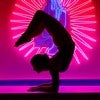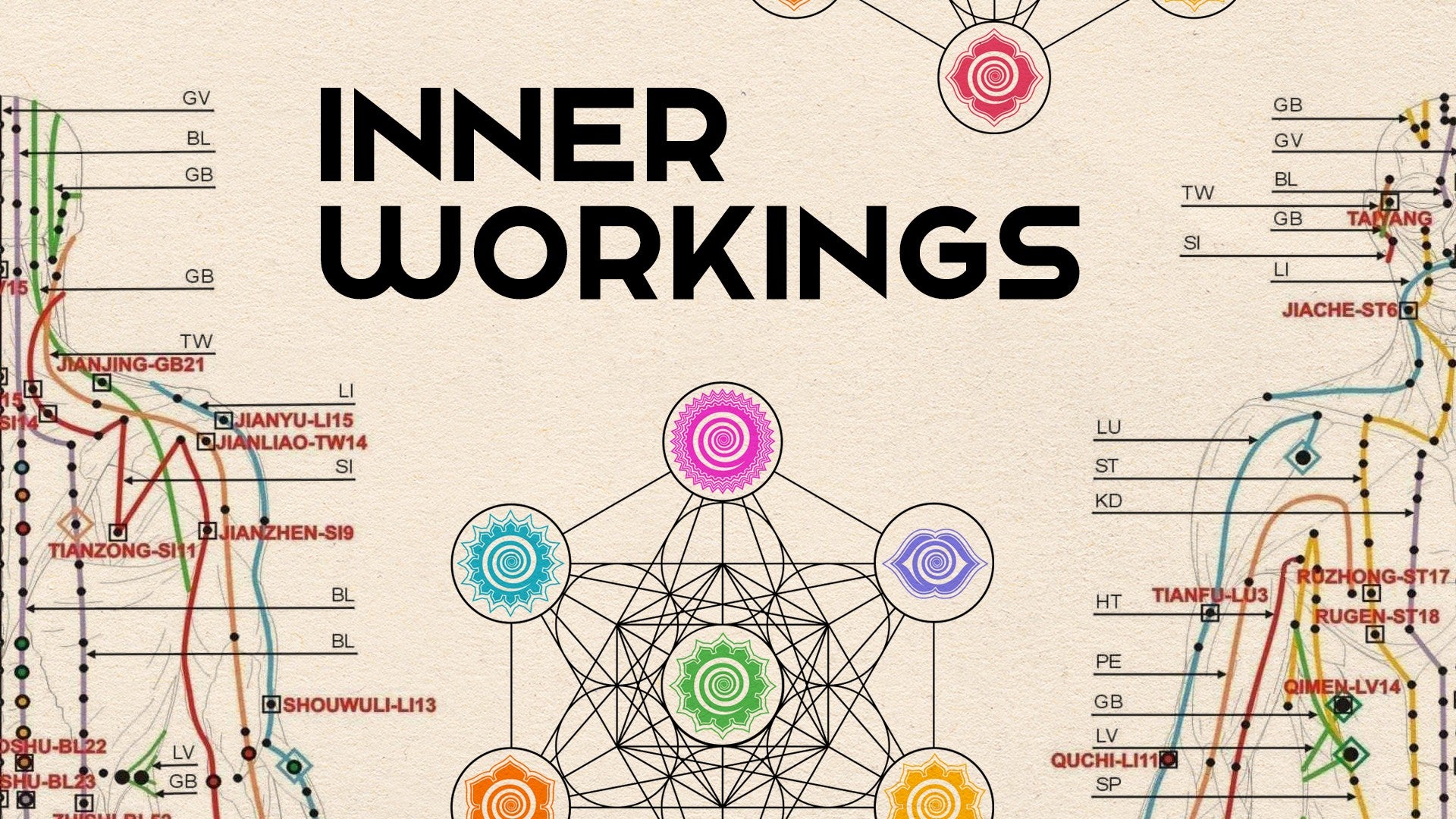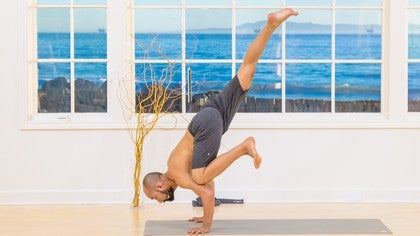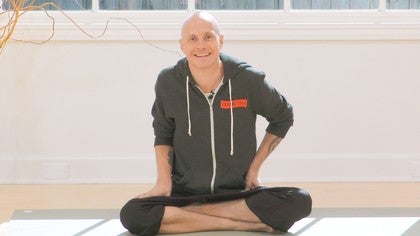Description
Here's a step-by-step practice forNauli Kriya.
About This Video
Transcript
Read Full Transcript
Salutations. Namaste. So we're about to begin an advanced vinyasa practice, an arm balance vinyasa practice. Remember, the most important thing here, you guys, is the concentration, the steadiness, sthira, sukham, asanam, sthira, steadiness, sukham, nothing should hurt while you're in the posture, if it does come on out. But the idea is to slowly build the strength and your joints and in your core and in the flexibility and everything, all that, over time so that you can maintain your breath as you move in and out of these asanas. So here we go. We'll start with the Gayatri mantra to begin. We'll end with a mantra as well, another mantra. And then we'll do some naali kriya to help to lift the organs, to help with our arm balancing and as well to bring us some awareness in the core. So feet together, big toes touching. Just look down at your toes and see that the toes are lined up evenly. Oftentimes they're not. The heels can be touching or they can be slightly apart, an inch to apart, depending on the anatomy. Now if your knees are coming together, then it's okay to bring the feet apart, but try to engage the legs in such a way that you can keep the feet together. Hands in the prayer position. Gayatri mantra, may the light of knowledge light and guide me along the path. Deep breath in for om. Om. Om. Om. Diyoyo na prachodaya atte, om Bhur bhuva swaha, tat savitur varenyam, bhargo devasyadhi mahi, diyoyo na prachodaya atte, om Bhur bhuva swaha, tat savitur varenyam, bhargo devasyadhi mahi, diyoyo na prachodaya atte, om shanti, shanti, shanti. All right, so step the feet apart, a little wider than your hips, naali kriya.
So first what we'll do is we'll just do the udiyana bandha to lift the organs up, and we'll hold that for just five counts, ten counts, or whatever you can hold, and then we'll take a couple breaths, and then we'll do agni-sara up and down just to loosen it up, and then we'll start moving and churning. There are other tutorials on the website for this, but we'll go ahead and just go right into it. Here we go. Inhale deeply, and then exhale through the mouth forcefully. Hold the breath out, pull the belly in and up. Release and inhale.
Now I was demonstrating with my hands closer to my hips, but typically when we do this, we're actually hunched over with the hands on the knees like this. So just for demonstration purposes, I'm sitting up a little taller. So feel free to come down like this. You don't have to copy me and do it like this. It's actually a lot harder to do it like this. All right, so now agni-sara, we're going to move the belly up and down.
The breath is held out. Breath is held where? Out. Exhale, hold. Release and inhale. So if you know not only Kriya, we'll go ahead and do it. If not, just continue doing it up and down or just hold it up.
Here we go. Big breath in. Exhale, hold. Take a few breaths and repeat. The longer you can hold your breath, the more times you can go around. When I started doing this, I could only do it maybe two, three, five times before I'd be gasping for air. Once you get the hang of it, you'll get to 10, 20, 30, 40, 50, 60, 70, 80, 90, maybe even 100.
My teacher David Williams went up to 100. I can only get up to 60. Here we go. We'll just do it one more time, 10, 15 times, as many as you can. Big breath in. Exhale, hold the breath out.
Suck it up. All right, take a few breaths. Meet at the front of our mats. Let us begin. Intermediate, advanced arm balance vinyasa.
Remember to keep your breath going as much as you can. Remember the bandhas, mula bandha, that'll help tremendously. Inhale, arms up. Look up, palms touch and exhale, fold. Empty the lungs completely.
Inhale, head up, half lift, and press your hands. Chaturanga, step or jump. Inhale, upward dog. And down dog. Exhale, draw the navel in. Hungry like a wolf.
Three, mula bandha, jalandhar bandha. Four, the secret is to exhale completely each time. And five, empty the lungs. Step or jump up, land between the hands. Inhale.
Exhale, the head down. Inhale, arms up, draw the navel in, mula bandha stays active. Palms touch, exhale, samasthiti, middle fingers on the IT van. Bend the knees, surya namaskar B. Bend the knees, inhale, arms up.
Exhale, fold. Hands next to the feet. Inhale, half lift, draw the navel in. If you can, keep the hands flat. That might be new for you. Step or jump, chaturanga.
Inhale, urdva, up dog. And exhale, downward dog. Gaze navel, deep breathing, mula bandha. Remember, yoga is invisible. Two, three, about 20% mula bandha.
Four, notice my low belly pulled in. Five, feet between the hands, lightly step, travel light. Exhale, head down. Inhale, arms up, reach, look up, palms touch. Lungs are full right here.
Exhale, samasthiti. Let's try another traditional sun salutation. Bring the hands together, inhale, reach up and bend back. Exhale, fold. Right leg back, inhale, stretch your hips.
Exhale, downward dog. Inhale, plank pose. Exhale, lower. Cobra or upward dog, inhale. Exhale, downward dog.
Right foot forward, inhale, stretch your left hip. Exhale, left foot forward, head to knee. Inhale, all the way up and back. Exhale, hands to heart. One more round, in, out.
Left leg this time, inhale, step it back. Exhale, downward dog. Inhale, shift forward. Exhale, lower. Inhale, upward.
And exhale, back. Left foot forward, inhale, stretch your right hip. Big stretch. Exhale, forward bend, head to knee, right foot forward. Empty the lungs, inhale, up and back.
Big stretch. Exhale, hands to heart. Watch your breath. Notice any tingling sensations along your spine. Alabunda, middle fingers on the IT band.
See that your toes are in line. Shut your eyes. Inhale, the arms up. Exhale, fold. We'll meet back in downward dog here.
If you have a handstand practice, feel free. Inhale, half lift. So you can exhale to downward dog or exhale to handstand. Take a breath or two. And we'll meet back in downward dog.
Don't hold my breath. Right leg up, big breath in. Exhale, right foot forward, warrior three. Inhale and lift. Any arm variation.
Crescent lunge, bend your right knee and slowly lower your left foot back. Inhale, stretch the arms up, keep the left leg straight. Stretch. Exhale, vinyasa. Inhale, upward dog.
Exhale, downward dog, lower the forearms. Breathe. You may stay in dolphin or take your legs up one at a time or jump, gazing between the hands or between the forearms. Breathe. If scorpion's in your practice, drop your chest and bend your knees.
And we'll meet back in downward dog any way you like. Stay with your breath. Inhale, lift your left leg up. Exhale, left foot between the hands, warrior three. Inhale and lift up, right leg up, arms up.
Chest parallel to the floor. Keeping the right pinky toe down. Right hip down, any arm variation. And crescent lunge, lower the right foot way back. Inhale and raise your arms up, keep the right leg straight if you can.
Take a back bend. Exhale, vinyasa. Left foot back, lower. Inhale, upward dog. Exhale, downward dog, lower the forearms.
You may stay here or take it up. This time you can do another variation if you like. You can take karandavasana if it's in your practice. I'm not sure if it's available for me today, but we'll see. You may take it up, scorpion or karandavasana.
And we'll meet back in downward dog. I don't think I'm coming back up, it's all good. Lightly step or jump your feet between the hands. Inhale and exhale, head down. Bend your knees as much as you can, keep your heels on the floor.
Inhale, come all the way up and samasthiti. Malasana. Let's vinyasa into that. Inhale, arms up. Exhale, fold.
Inhale, half lift. Step or jump. Chaturanga. Inhale, upward dog and downward dog. So malasana, the feet outside the hands, you can step or jump into it.
Try to go as light as you can. Feet can be apart. So I want you to make sure your knees are happy. If turning your feet parallel, torque your knees, don't do it. Yoga is fun, but walking is more fun.
Keep the knees happy. You can press your elbows against your knees to open them up, open the hips. Draw the mula bandha in and up, straighten the spine, one variation. Another variation would be to bring the feet together, heels and toes together, feet flat. You can stretch forward or bring the hands around and catch your heels.
And you can stretch the head to the floor. That might be enough. Or eventually your forehead will touch your toes. From here you may take bhakasana. So bring the feet closer together, the knees behind the arms.
You can keep the elbows slightly bent or straighten the arms all the way. Take a number of breaths, and when you're done, you can take ekapada, bhakasana, one foot, or chaturanga. Malasana, step or jump, land as lightly as you can. Again, feet together or apart. If you've been doing the feet apart for a while, maybe try bringing the feet together.
The heels will come together first, then the toes will come together. But push yourself forward, use your elbows, and stretch your hips, stretch your spine. And bhakasana, ekapada bhakasana on the other side if it's available. From here, half pigeon, inhale, lift the right leg as high as you can. Exhale, the right knee towards the right wrist.
Your right foot can be near your left hip. I know sometimes people say you should bring the foot all the way up, but I've found that people can tear their knees if their hips are tight. So again, be mindful of your knees. You can even do it like this if it feels better for you. And slide your left leg back.
Inhale, sit up as tall as you can. And exhale, walk your hands forward, and fold over your right shin. Notice your breath. And your mula bandha. You may stay here or sit up.
You can take ekapada rajakapultasana, one foot king pigeon, or simply just reach back and catch your foot. You can hook. This is a merman, a mermaid. Or you can take your vine, you can flip your grip, or you can use a strap if you have one handy. And work on bringing the hands closer to the foot.
You should be able to breathe in your pose. Another nice variation is with the half lotus vine, if it's available for you. And here's a neat transition. So remember that pose we just did, ekapada bhakasana, one foot crow pose. So what we're going to do, think about this, you're going to take the left knee to the left arm.
And you're going to do that while you press your hands into the floor and kick the right leg back. So you're going to pick up, take the legs and switch them. Place the left knee on the back of the arm. So lift the hips, press the hands, inhale, lift. And then yasa.
Inhale, left leg up. As high as you can, exhale the left knee to the left wrist. Slide the right leg back, preparing for half pigeon. Inhale, sit up tall. Exhale, fold over your left leg.
Walk your hands forward. And notice your breath. Mulabunda. You may stay here or sit up, ekapada raja kapodasana, one foot king pigeon pose. So simply just catch your right foot, get a stretch in your quad or merman.
Or you can flip your grip or take a strap. When I started yoga, I couldn't even sit up in this pose ten years ago. So find the position that feels the best. You can also take the bind, left hand back to catch the left foot. Work your pose, but more importantly, work your breath.
From here, that funky transition, you can press your hands into the floor. Think arm balance, right? You're going to press the hands in, pull the belly in, mulabunda. You're going to take the right leg to the right arm while kicking the left leg back. Ready? Inhale, pick up.
Vinyasa. Vinyasa all the way to standing. Look between the hands. Lightly step or jump your feet right between the hands. Exhale, head down.
Inhale, come all the way up, reach, mulabunda, don't forget. Exhale, release the arms. Pause for a moment and just scan your body. Notice all the prana, the tingling up and down your spine, the shoulders. Notice your breath, the energetic body, subtle body, just notice.
Pranamaya kosha. Equalize your breath, equalize your mind. Sama, equal, total, samadhi, equanimity. Inhale the arms up, reach and look up. Exhale, fold.
We'll meet back in downward dog. If you have a handstand practice, go there. Lightly step or jump feet between the hands and squat. If the heels are coming up, you can take your mat, roll it up or fold it up. We'll take pashasana, the twist.
Twisting to the left, I like to lengthen first. Right hand on the left thigh, lean back, twist. Two pops and slide around. You can reach the hands back, bind if it's available. Today, it is.
If not, twisting prayer is fine or having the hands. I did this for years. From here, release the hands. Sidecope, crow, parshva, bhakasana. Try not to, notice what happens to my shoulder when I place my left hip, my left elbow.
See if you can keep both shoulders back. If not, it's fine. Open the legs, switch legs and vinyasa. Step or jump, feet between the hands and we'll twist to the right side. Lengthening and twisting and of course breathing.
Take your twist, either keep the arms open or try to bring the thigh to the outer left ribs. Draw your navel all the way across. If it's available, reach back and bind. If not, just keep the arms open. I'm going to turn 90 degrees so you can see this a little better.
But you'll place both hands down. You'll press up into sidecrow, open the legs. Switch legs and vinyasa. From the down dog position, bhujapidhasana, arm pressure pose. You can either step or jump your feet around the arms like this and then lower back.
Cross your legs, right foot on top. Stay here, pull the feet through. Nothing touches the ground but your hands. Or you can float into it like this. Then from here, you can take titibhasana by pushing, crawling between her legs.
Shoulder behind your knees if you can. And vinyasa. You can actually jump into the pose and see if it happens today or not. And lower your knees and check child's pose. Preparing for headstand next.
Five more breaths. Try to equalize the quality of your breath, the length and the quality. See if you can make it sound the same on both the in and out breath. One. Two.
Notice at the end of the exhalation, you can do a better mulabunda. Three. And at the top of the inhalation, keep your mulabunda so you don't push anything out. Four. Five.
Shri sasana headstand supported. Head down. Do not jump. Go up lightly. Legs stay together, feet together and breathe.
Find your center, samasthiti. And if you can twist to the right, that means your feet will turn to the left. And back to the middle. Exhale, twist to the left. That means your feet will point to the right.
Back to the middle. Baddha konasana, keep the heels together, soles of the feet together. Push your knees back, open the hips. Inhale, open the legs. Exhale, bend the knees.
Once more, inhale and open the legs. Exhale, bend the knees, feet together. Inhale, straighten the legs, take it up. And you can take the lotus position, slide the right foot down the front of your left leg, turn the left leg out, bend the left knee, take the lotus. Try to walk your feet close to the hips.
And lower your knees halfway. Draw the belly in, mula bandha. Don't stop breathing. So from here, we'll take a vinyasa. You can lower down any way you like.
We'll meet back in down dog or child's pose. And we'll meet back in the seated position when ready. We'll start our prana yama practice. Find a comfortable seat. Prepare for prana yama, prana, ayama, the expansion, regulation, or control of your breath.
Inhale, try to stay with me. I'll do it with you. Exhale, in, out, mula bandha. In, draw the navel in. Out, don't lose the mula bandha.
In, out, hold. In, out, hold. In, out, hold. You do your bandhas when you hold. In, out, in, hold.
Bandhas, out, hold. In, hold. Out. And hold, bandhas. In.
Hold, out, hold. In, out, in, and out. In, out. You may lay down or remain in meditation for just a minute, or you may stay in Shavasana a little longer. Notice the quality of your mind, quality of your breath, the number of thoughts have been reduced significantly since you started.
Anchor your mind, keep it on your breath. And as you breathe in, know that you're breathing in. As you breathe out, know that you're breathing out. I'd like to offer the great Maha Death Murutayanjaya Conquering Mantra, Maha Murutayanjaya, the Great Death Conquering Mantra to close. At the time of death we are free, but the goal in yoga is to experience this freedom before death.
You should always think of God, and if you can't, you think of death, because death will bring you there. Om triyam bakam yajam hai sughandim pushti vartanam Urava rukamiva bandhanam brityormukshya mamrataat Om triyam bakam yajam hai sughandim pushti vartanam Urava rukamiva bandhanam brityormukshya mamrataat Om triyam bakam yajam hai sughandim pushti vartanam Urava rukamiva bandhanam brityormukshya mamrataat Om Shanti, Shanti, Shanti Om Shri Guru Bionamah Rihi Om Namaste, salutations.
Inner Workings: Jani Jaatinen & Ricky Tran
Comments

You need to be a subscriber to post a comment.
Please Log In or Create an Account to start your free trial.







